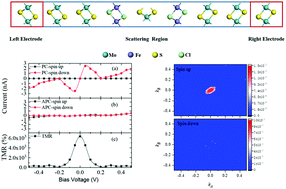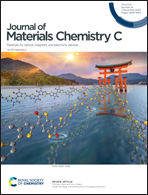FeCl2/MoS2/FeCl2 van der Waals junction for spintronic applications†
Abstract
Atomically thin 2D magnetic materials have attracted increasing attention due to their promising applications in spintronic devices. Although more and more 2D intrinsic ferromagnetic materials have been theoretically predicted, few of them have been experimentally synthesized due to the thermal fluctuations at finite temperatures, and unfortunately, they have either low Curie temperatures or low spin polarization, which is not beneficial to spintronic applications. Very recently, the predicted 2D ferromagnetic half-metal of 1T-FeCl2 with 100% spin polarization, high Curie temperature and large magnetic anisotropic energy has been grown by molecular-beam epitaxy. In this work, we propose a vertical 1T-FeCl2-based van der Waals junction of 1T-FeCl2/2H-MoS2/1T-FeCl2 with the electrode of 1T-MoS2, which has the advantage of clean interfaces compared to the lateral 2D heterostructures. Our calculated spin transport properties based on the first-principles and the nonequilibrium Green's function method indicate the excellent spin filtering effect and negative differential resistance effect as well as the high tunnel magnetoresistance ratio (up to 6300%). The physical mechanisms are discussed in terms of the spin-resolved junction density of states and the energy- and momentum-resolved spin-polarized transmission spectra. The standing wave pattern and the quantum-well resonances are observed in the junction. These results suggest the potential 2D spintronic applications for the experimentally synthesized atomically thin 1T-FeCl2, and will stimulate experimental and theoretical studies on van der Waals magnetic tunnel junctions.



 Please wait while we load your content...
Please wait while we load your content...